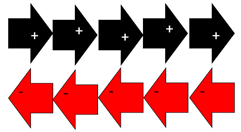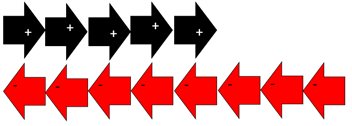The purpose of this activity is to support students understanding and fluently carrying out subtraction with integers.
Students must confront the over-generalisation that subtraction always makes the answer (difference) less than the starting number (minuend). When a negative integer is subtracted, the answer is greater than the starting number. For example, +4 - -3 = +7, and +7 is greater than +4. Within this activity, you might introduce relevant te reo Māori kupu, such as tau tōpū (integer).
- Remind students about what occurs when integers are added. You might use a number line and/or integer cards as a prompt.

- Have students act out additions with a sequence, such as:
- Start on zero and add positive four. Where are you?
- Now add negative five. Where are you?
- Now add negative six. Where are you?
- Now add positive eight. Where are you? (Students should finish on positive one).
- Discuss:
What happens when we add zero?
If this is what happens when positive and negative numbers are added, what do you think happens when positive and negative numbers are subtracted?
- Let students discuss their ideas. Look for a sense of anticipation.
Capture their ideas as a diagram. Many students are likely to be correct in anticipating that negative integers behave in an opposite way to positive integers.
- When you subtract a positive number which way do you face? (to the left)
To the left is the subtraction direction with positives. Then you walk forward.
Act that out with 2 – 5 = -3 on a number line.
- When you subtract a negative number, you still face the left.
Do you walk forwards or backwards? (backwards)
Act that out with -6 – -4 = -2 on a number line.
- Let’s start with a balance. What amount is shown here?

Students should recognise that this is one way to make zero, since there are the same numbers of positives and negatives.
- Now I am going to subtract +3. What will the result be? (A balance of -3)
Record the operation as 0 – +3 = -3.
- Return to the previous zero balance (Positive 5 and Negative 5). Act out other subtractions as ‘takeaways’. Good examples might be:
- 0 – -5 = +5
- 0 – +1 = -1
- 0 – -2 = +2.
- Make a model with a balance of negative three, such as:
Make up different subtraction equations, beginning with the number -3 (negative three).
Record your equations and check the answers you get on the calculator.
- Roam as the student/s work. Look for:
- Do they connect the subtraction with the correct physical action? For example, is –-3 shown as removing three negatives?
- Do they correctly write the equation?
- Do they get the correct answer and confirm the result on their calculator?
- Do they anticipate the direction of the change, as more or less than the starting number?
- Conclude by combining equations and number lines to represent subtractions. For example:
- 3 - -4 = 7 might be shown as:

- -4 - -7 = 3 might be shown as:

- 3 - -4 = 7 might be shown as:
Next steps
- Provide subtraction problems where the starting number (minuend) and the answer are known but the number subtracted is not. For example:
- -5 - □ = -3 What number is □? (□ = -2)
- 4 - □ = -1 What number is □? (□ = 5)
- Extend the interpretation of subtraction to difference. Begin with positive numbers using a number line.
- What is the difference between 2 and 9? The problem can be written as 2 + □ = 9 or 9 – 2 = □. In both cases the box number is 7.

-
What is the difference between 8 and -3? The problem can be written as -3 + □ = 8 or 8 – -3 = □. In both cases the box number is 11.
